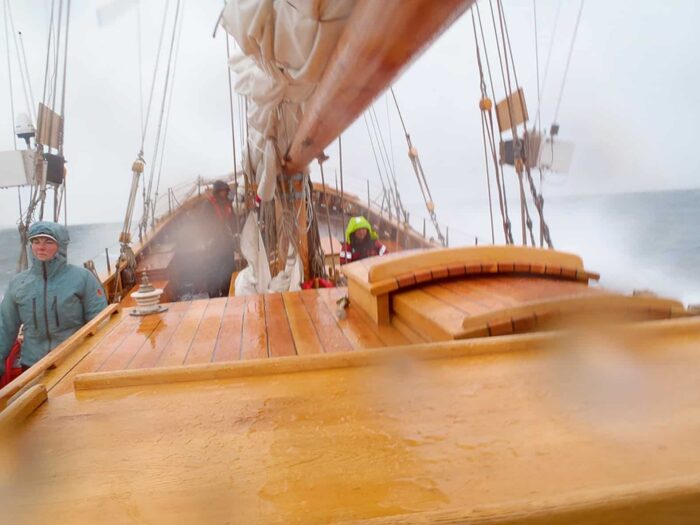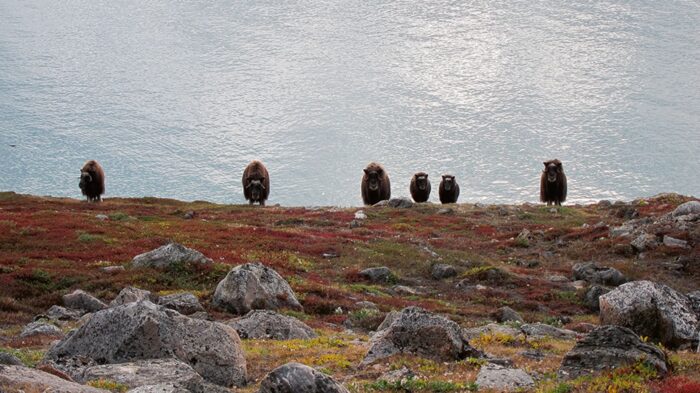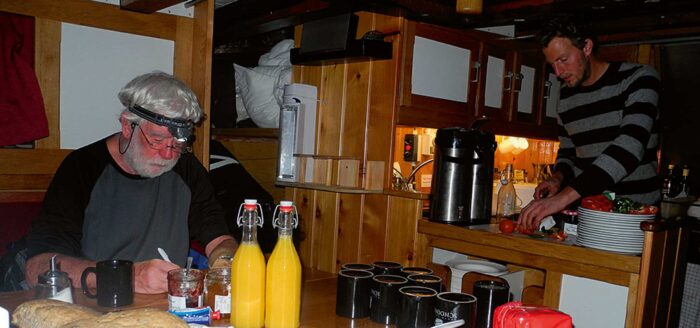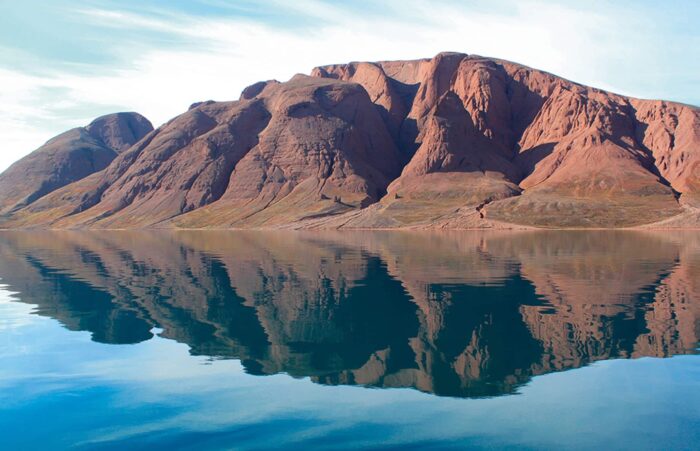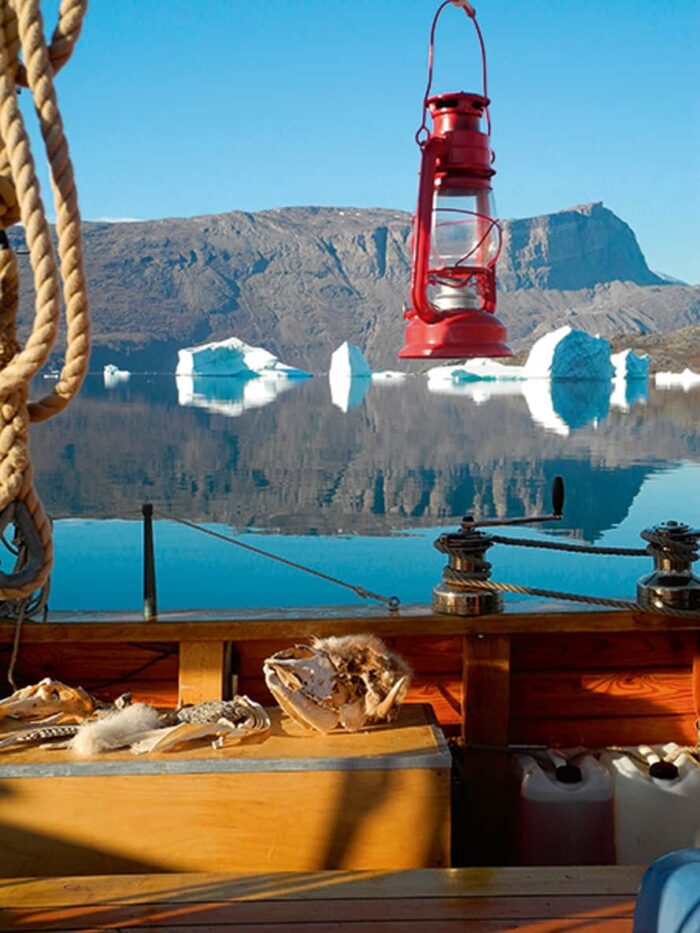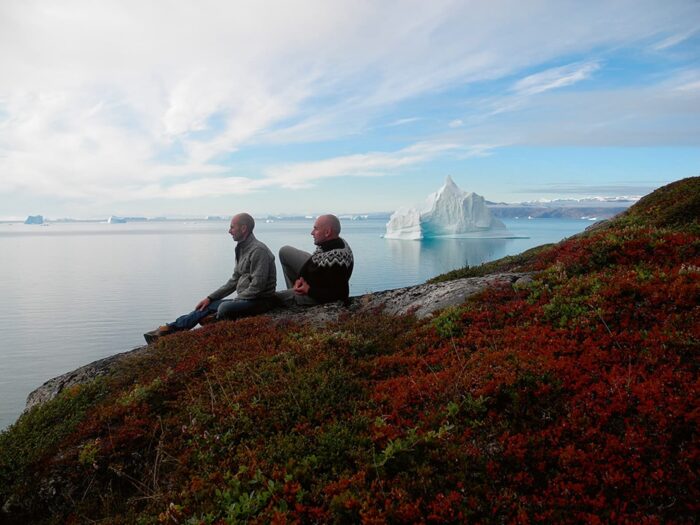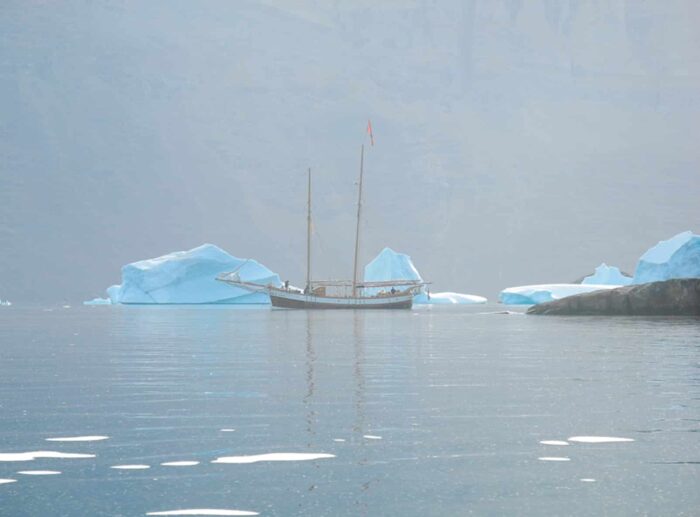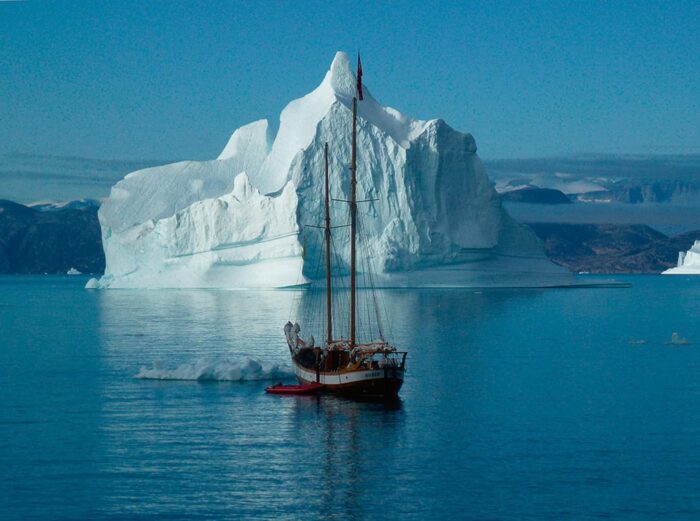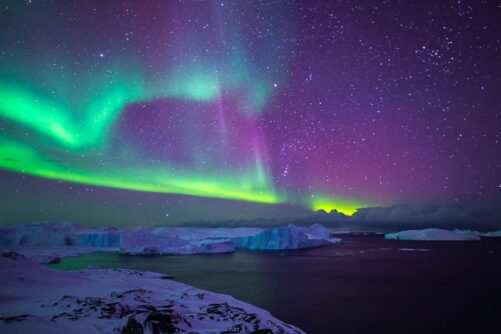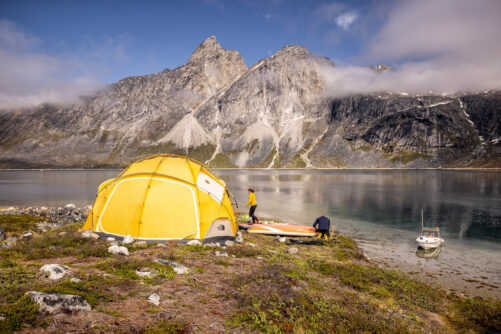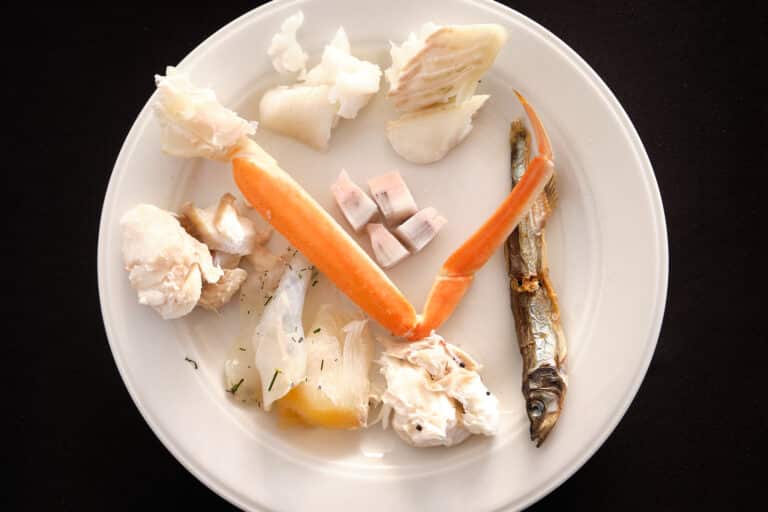
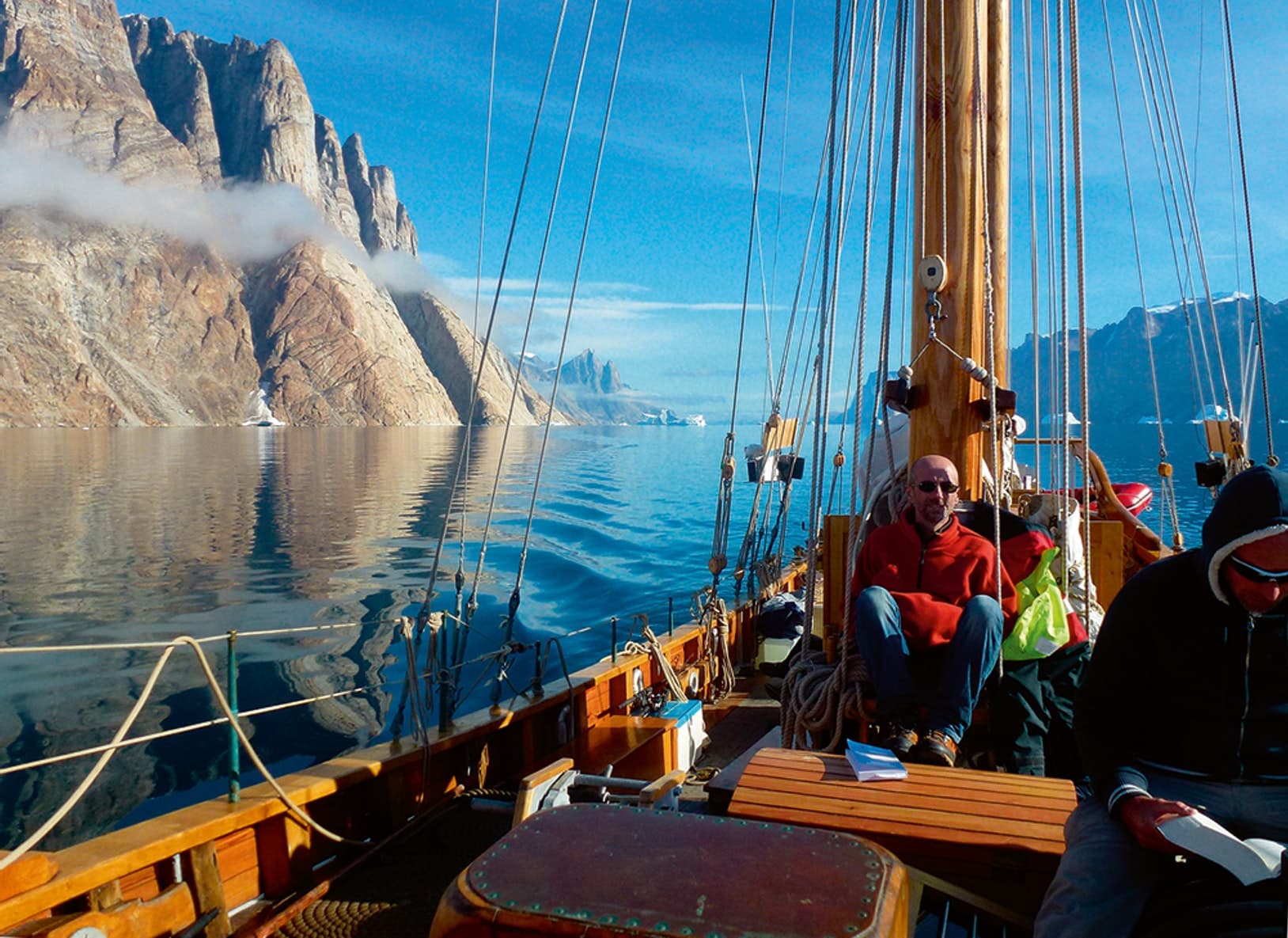
Sailing with sails in Greenland
Published: 26/10/2021
Reading time: 18 minutes
Sailing with sails in a schooner in the world’s biggest fjord on Greenland’s east coast is not simply a journey between icebergs and glaciers. When you sail in these magnificent natural surroundings, without a cell phone or internet connection, it turns into a journey inside yourself.
I stand outside the airport in Nerlerit Inaat (Constable Point) and look across the water at the end of the runway, where the old, wooden, two-masted schooner Hildur lies at anchor, waiting for us.
The air is completely clear and the water is as flat as a pancake. Reflections of the sun’s rays glint in a myriad of sparkles on the surface of the water all over the fjord. Not a sound is heard until Air Iceland takes off, heading for Iceland and then it is the turn of Air Greenland’s Bell 212 helicopter, taking passengers to Ittorqoortoormiit town.
Then it is quiet again. Overwhelmingly quiet in the massive stretches of nature that surround us. There are huge mountains on one side and water on the other side. It feels almost surrealistic to stand here on the border to Greenland’s National park, less than twenty-four hours after leaving busy Copenhagen.
To Greenland from Iceland
The trip to Greenland’s east coast has only taken 1 hour and 40 minutes from Iceland, yet I feel I now know everything about the 83-year old sitting next to me, an Australian from Adelaide. It is nice with some good conversation on the flight, be-cause we are both excited. Only when the fantastic mountains on the east coast loom up ahead, with glaciers and inland ice in the background is the man in the seat next to me rendered speechless with wonder – as I am.
Now we are both standing here, breathing in the atmosphere and the pristine, Greenlandic air. We enjoy the peace and admire the knife-sharp image of nature in the bright sunlight. We are offered transport down to the ship in the airport pickup, but I make do with wheeling my luggage and enjoying the walk down to the water, watching the ship emerging in all its detail, as we get closer.
Welcome on board
Captain Alli is an experienced captain with many sea miles under his belt. He welcomes us on board and presents his crew, before offering dried fish with butter and aquavit. We weigh anchor while everyone is still on deck. One-by-one we are shown our quarters, because there is not enough room for a group tour. We are each given an alcove or a bunk, instructed in moderate water consumption and asked to wash sparingly, until we can refill the water tank from a spring in the fjord.
The weather is beautiful, but a fjord wind rises quickly and with lots of ice in the water, it is too dangerous to set sail. The wonder of being on the move turns the wind and weather to lesser factors. Gradually, as the swell increases, people are obliged to go down and test their bunks. Dinner is therefore late that first evening and it is midnight before people settle down.
Night watch
We sail all night and I cannot get myself to go to bed. The entire crew is on deck because of the unfortunate combination of ice and swell. The ice watchman stands in front, in the bow, shining the floodlight far ahead of the ship. His signals are clear and concise and the skipper reacts promptly, swinging to port or starboard.
At one point, the ice watchman raises both arms in the air at the same time and the captain quickly stops the ship, because he is not quite sure how to interpret the signal. A sheepish and penitent ice watchman walks towards the captain on deck. He was tired, so he had stretched his arms and he apologizes profusely. Captain Alli pats his shoulder encouragingly and smiles. None of them has slept much in the past 24 hours, but their spirits are high. We are underway.
The reward
We are still sailing at five in the morning and we have seen many gigantic icebergs pass by in the light summer night.
The storm has long since died down and freshly baked bread and coffee appear from the galley as the sun tinges the sea with yellow and orange. How is it possible to go to bed? One iceberg resembles a hare, another looks like a recumbent man.
We chat of this and that while the rest of the ship starts to wake. The morning sun makes the clouds on the horizon blush in rosy shades, until the first yellow-white rays reach the mountaintops, bringing them out of the black and white performance of the night and it is as though the landscape is painted with colour in front of our eyes.
Even those who have come on deck to quickly see where we are, forget they are barefoot and stay standing in wonder, enjoying the sight. This morning makes the whole tour worth it, and we have only just begun. Fantastic.
Mountain wanderer
We sail to a small inlet called Syd Kap, where the ship had previously set Icelandic Vildborg ashore. She comes out of the small house there, when she hears the ship’s horn announcing our arrival.
The Greenlanders’ legends of the wanderer called Qivitoq, who lives alone in the mountains, does not seem to have scared the young, blond, shore-bound Viking.
While we are casting anchor, the landscape behind her suddenly moves and a herd of six adult musk oxen and two calves move calmly in the background. There is plenty of time to capture them on camera.
For a whole year, Vilborg has been planning to stay in the mountains alone to expand her comfort zone, as she says. It has apparently worked, because we do not meet a scared person.
Hiking in East Greenland
We are ashore for three hours and run around the fells like sailors on their first shore leave.
Below us, the ship lies at anchor and as far as the eye can see, there is the fjord and icebergs. We sit down on the mountainside, where heather and other plants are already in their autumn colours. It is beautiful. The glorious shades of brown, yellow and red colours make the mountainsides contrast beautifully with the blue fjord and the white ice.
A sound like thunder rolls repeatedly over the fjord and we quickly realise that it is caused by the movement of the icebergs.
Sunshine on board, moonshine at night
After sailing for some hours, when I finally get some shuteye, we reach our anchor site for the night.
We go ashore in bright sunshine at six in the evening and while some walk to the top of the mountain, others of us enthusiastically follow the bed of an extinct glacier and the impressive deposits of mud, sand and rocks of all sizes it carried with it, before it disappeared.
Everywhere, there are masses of Greenland’s national flower, Niviarsiaq (Rosebay Willow Herb), fragrant heather and mushrooms of all types and sizes.
Mysterious stones in Greenland
We see large rocks on several of the mountaintops, as if a gigantic hand placed them there. It is something of a mystery for the uninitiated, how such large blocks of stone could have been laid so they almost teeter on the pointed mountaintops. They are the final salute from extinct glaciers that have carefully laid the stones there during their last summer. The ice melted around them hundreds of years ago.
Back on the ship, there is a grill party on deck and as the sun disappears, the talk continues inside in the galley. It is obvious that we are all already getting on well after the first twenty-four hours. Afterwards, I enjoy my first quiet night’s sleep, surrounded by glassy water.
Life on board
We sail every day and there are daily walks when we arrive at our destination. Those who wish can follow the guide up the mountain or to the hinterland, while others enjoy the coastal regions and views, which are quite unique everywhere we go.
Magnificent and infinitely beautiful is a description that fits many places in Greenland. But here, things have been sort of multiplied and are infinitely bigger than other places I have seen. The horizon seems endless, the icebergs gigantic and it takes hours to pass the glaciers. It is truly the world’s biggest fjord.
Each day’s sail is a pleasure. We slowly glide through the fjord with high mountains and deep valleys on each side, watching iceberg after iceberg float quietly past with the sun sparkling like a thousand small mirrors, while there is creaking and movement and the meltwater cascades in small waterfalls down the sides of the icebergs.
Drinks with inland ice
It is a long trip, but time passes quickly. We are all engrossed by the nature around us and people sit or stand on the deck for hours without saying a word. We are all taken over by something bigger than we are.
Sebastian, the cook, spoils us, with musk-ox steaks bought from local hunters, fish and salads, pasta and freshly baked bread. Everyone on board appreciates his ingenuity.
We swap stories and laugh a lot. There is room for everyone, both those who want to be by themselves and those who want to enjoy a nightcap together with the others.
Every day we are offered evening drinks with inland ice and you can hear that this is the genuine product when thousands of years of compressed air bubbles are released with a sparkle.
Animal life in Greenland
We watch polar hares that willingly allow themselves to be photographed up close. And after a while, we see so many musk oxen, that no-one gets out a camera, if there are less than five in a herd. One evening, we see an Arctic fox in its dark brown summer attire. It is in a hurry and quickly disappears again.
We make do with the hand basin most days, but the ship has a simple shower. Although it is cramped and water must generally be used sparingly, it is absolutely marvellous when you have been walking in the mountains. It may be just a small thing, but it makes us think about, and appreciate things we otherwise would take for granted in our lives.
In full sail
– »We sail«. Captain Alli’s voice rings out over the ship when the sails are set and the engine stops.
The order brings the crew into highest gear and all the guests on deck. Ropes are loosened and pulled through rings on the deck, ready to pull sails and booms. The ropes around the sails are untied and there is hectic activity everywhere until everyone reports back to the Captain. The guests are then divided into groups to help the seamen at their posts and the hard work of hauling up the sails begins.
The engine is stopped and the schooner shoots silently through the water while the wind fills all the sails. It is a marvellous experience. This is what it must have been like hundreds of years ago, when the first explorers came here to map the wild stretches of the east coast. We suddenly realise how hard it must have been and how the mariners of the day were at the mercy of the whims of nature. For weeks, they waited for wind and at other times, they were hove-to because of too much wind.
In times where everything has to be green and environmentally friendly, sailing like this has to be very close to being the most correct form of transport, with the addition of a tiny blast from the past and a cautious feeling that we guests are also a kind of mariner.
Meltwater plains and sea ice
In many valleys, there are huge banks of sand, rocks and gravel between high mountains. These are the beds of now-extinct glaciers that have deposited millions of tons of material before they melted and disappeared. Now, stones and rocks remain as far as the eye can see.
On the days where the water is perfectly calm, icebergs, hummocks and small chunks of ice are spread like pieces of a huge puzzle, we cannot just sail through, So Captain Alli sends ship’s mate Remy up the mast, to find a path through the ice.
Over the radio, we can all hear him steer the ship to starboard, port and sometimes full stop. From both sides of the bow, people help with boat hooks, preventing the worst ice hummocks from contact with the ship’s hull.
Occasionally, small chunks of ice clink along the sides of the ship, but we are all impressed with the crew’s ability to find a path through the ice. We take it, for the huge experience it is, and everyone is on deck, following events with interest.
East coast hustlers
In Hare Fjord, we meet a team of Englishmen who have been coming here on holiday for twenty years. Previously, some of them have worked with selling holiday tours to e.g. Greenland, another is an ornithologist and there is a biologist and so on. The fact that they are retired does not prevent them from sailing to new places in the world’s biggest fjord. However, they no longer go higher up in the National Park to climb, as they did when they were younger.
In the middle of their camp stands Tarzan the dog, also a veteran in East Greenland and very pleased to meet new people. He is a good friend to have along as an alarm in camps in polar-bear-country.
The only first-time visitor in the tent camp is Steve, who is not retired, but an artist who teaches drawing in Glasgow. He shows us some sketches while he enthusiastically tells what an intense experience it is has been for him, living here for nine days.
No global footprints in Greenland
Everywhere in their camp, there are barrels in different colours, because they do not want to leave anything behind in nature.
We leave with a smile on our lips. They were fantastic personalities, clearly incurably smitten by »the Greenland virus« that has driven them up here time after time. You only have to lift your eyes and look around to understand them. Dependency upon Greenland’s nature is not the worst thing you can suffer from.
The Greenlandic town Ittoqqortoormiit
The last stop on the tour is the northernmost town on Greenland’s east coast, Ittoqqortoormiit. Here, a group of the town’s children watch excitedly from the water’s edge while we drop anchor. They wave and smile and we feel very welcome, coming back to civilisation after a week in the wilderness. The same applies when we go for a walk through town. Everywhere we meet smiling adults and children who do not mind stopping to show the way or to answer questions.
Hospitality in Greenland
We receive an invitation to eat with a family where the mother, Grethe Pike lives alone with her three youngest sons. She has cooked roast musk ox and there is plenty. She answers questions while we enjoy the meal. Yes, polar bears often visit the town, says Grethe Pike. She tells how, in the spring, a polar bear came to visit, sniffing around the front door. They have therefore acquired a dog that lies outside with its puppies, making an efficient polar bear alarm.
She also shows photos from the winter. She was vacuuming and suddenly she saw a mother polar bear with two cubs walk past on the sea ice below the window. She was not afraid, not even for her boys, who grew up here and who know the conditions.
Grethe tells that the town once had more than 600 inhabitants, but now there are only a little more than 400 people. Young people, in particular, do not come back after they have finished their education, although some do and the town needs them to fill the jobs in town and to build the future, she explains.
Living with the Polar Bears in East Greenland
After dinner, there is coffee and Greenlandic marble cake with whipped cream. As we enjoy the cake, 18-year old Inunnguaq comes home. After greeting all the guests, he starts washing the dishes of his own accord. We ask with interest how Grethe has taught him to do this, and she answers modestly that her children have always helped with housework and that it is a natural part of their upbringing.
Inunnguaq has just returned home after three years in Nuuk where he was a high school student. He dreams of becoming a pilot, but first, he would like to improve his English, he tells us. With the energy and drive he exhibits, he will surely achieve his goals in life.
Only people of a special calibre can live here, with five to seven metres of snow in the winter and polar bears in the backyard. Either that or it is the living conditions here that create people of a special calibre.
Life affirming
I leave the east coast with a feeling of peace and tranquillity that I have not had for years. The country, the fjords, the wildlife and not least the people who live here have made a strong impression.
My own, easy life is put sharply into contrast by this sailing trip in the world’s biggest fjord and by the visit to an optimistic town with strong personalities living on the edge of civilisation.
This was not just another tour, but rather a unique experience that has taught me to appreciate my life in a completely new way.
Facts about »Hildur«
- Length: 26 m
- Beam: 4.8 m
- Sail area: 250 square metres
- Hull material: Oak
- Masts: 2
- Keel: 8 tons
Facts about the passengers
Before I left, I was very curious about who goes on a cruise without modern conveniences, cut off from the outside world. It proved to be a very mixed bunch.
- The oldest is Angus, 83 years old who comes all the way from Adelaide in Australia to participate. The year before he had gone to Greenland to sail on the west coast, but he became ill and he spent three days in hospital in Nuuk instead. However, this did not deter him from still wanting to see Greenland and he was therefore one of the first to buy a ticket for this special cruise.
- Ann and Allan, 64 and 72 years old from Wales, have travelled around the world in their own way, e.g. by car through Africa and many Arab countries. They had never tried a package tour before and had joined because of the uniqueness of sailing in a different, not luxurious manner, in a part of the world they had never dreamed of seeing.
- Hjalmar and Lydia, 50 and 53 years old from Iceland, own their trawler and fish factory and mostly take their holidays under southern skies. Since Lydia was 14 years old, she has dreamed of seeing Greenland and she finally succeeded in enticing her husband to join her.
- Michelle and Paolo from Lake Como in Italy like places where there are few people and where they can feel the power of nature. They felt this tour was a great opportunity for the holiday of a lifetime. After the tour, they were married on board the ship.
- Vilborg, 31, Reykjavik, Iceland, had been planning a week’s solitary sojourn in the mountains for a year. She loves Greenland and wants to return to cross the inland ice one day.
- Anton, 49 years, and Gunnar from Iceland usually hike, fish and go hunting together. They could not resist temptation when they heard about the tour, although no fishing or hunting was involved. They both want to experience more of Greenland and both want to come back some time to do some fishing.
Facts about the crew
- Martin, 33, Ulm, Stuttgart, Germany – ship’s mate and cook
He has previously lived for six months in Upernavik and for a total of two years in Iceland. He wants to make films. - Sebastian, 27, Onsala, Göteborg, Sweden – cook
He is a sociology student and this is his summer job. He wants to work with environmental issues. Plays improvised jazz in his spare time. - Remy, 28, Nouméa, New Caledonia – ship’s mate
He has previously lived for six months in Upernavik. He loves the Arctic climate and the people. He feels alive here in the north »because it is not easy«. He enjoys the small things. He wants to sail and learn more about sailing. - Alli, 58, Husávík, Iceland
He has been a fisherman since he was 15 years old and he has always sailed. Greenland is beautiful, but very different from anywhere else he has sailed, because you always have to keep watch for the ice and the weather.
Find your adventure in Greenland!
Read more travel blogs from Mads Nordlund
-
5.00(1)1 To 6 Passengers Included

Private Catch’n’Eat | Qooqqut Nuan | Nuuk
Tour startsNuukDuration6 hoursFrom 14500 DKKSee more -

Boat tour Uummannaq 360°| North Greenland
Tour startsUummannaqDuration2 hoursFrom 1600 DKKSee more -
4.90(10)Flexible departures!

The Great Russell Glacier | Kangerlussuaq
Tour startsKangerlussuaqDuration2.5 hoursFrom 2100 DKKSee more -

Whale & Musk Ox Safari by boat | Uummannaq | North Greenland
Tour startsUummannaqDuration8 hoursFrom 4300 DKKSee more -
5.00(1)

Evening sailing with chance of Northern Lights | Nuuk
Tour startsNuukDuration3 hoursFrom 950 DKKSee more -
Flights from Denmark included!

5 Days full of Icebergs, Northern Lights & Arctic Culture | Ilulissat
Tour startsIlulissatDuration5 daysFrom 15700 DKKSee more -
Small groups!

Sail With The Whales with an open boat | Ilulissat | Disko Bay
Tour startsIlulissatDuration2 hoursFrom 1200 DKKSee more -
5.00(2)1 TO 6 PASSENGERS INCLUDED

Private Qoornoq Island Adventure | Nuuk
Tour startsNuukDuration4 hoursFrom 9000 DKKSee more -

Assaqutaq Trail Transfer | Sisimiut
Tour startsSisimiutDuration5.5 hoursFrom 700 DKKSee more -
5.00(2)

5-Day Adventure Camp in the Heart of Nuuk Fjord | West Greenland
Tour startsNuukDuration5 daysFrom 13000 DKKSee more -
New tour!

Experience Life on a Reindeer Station | 7 days | South Greenland
Tour startsNarsarsuaqDuration8 daysFrom 26400 DKKSee more -

Snowshoe to the top of Lille Malene | Nuuk
Tour startsNuukDuration5 hoursFrom 3190 DKKSee more -
New tour

Dog sledding tour to the UFO cabin | Sisimiut
Tour startsSisimiutDuration4 hoursFrom 2100 DKKSee more -

10 days of hiking through Arctic nature & villages | East Greenland
Tour startsFrom IcelandDuration10 daysFrom 35700 DKKSee more -
5.00(3)

Ghost Village Boat Cruise | Sisimiut | West Greenland
Tour startsSisimiutDuration3 hoursFrom 1040 DKKSee more -
1-10 people included

Boat charter | Open Boat | Qasigiannguit | Disko Bay
Tour startsQasigiannguitDuration2 hoursFrom 1600 DKKSee more -

Whale Watching and Iceberg Safari | Tasiilaq | East Greenland
Tour startsTasiilaqDuration3 hoursFrom 1400 DKKSee more

